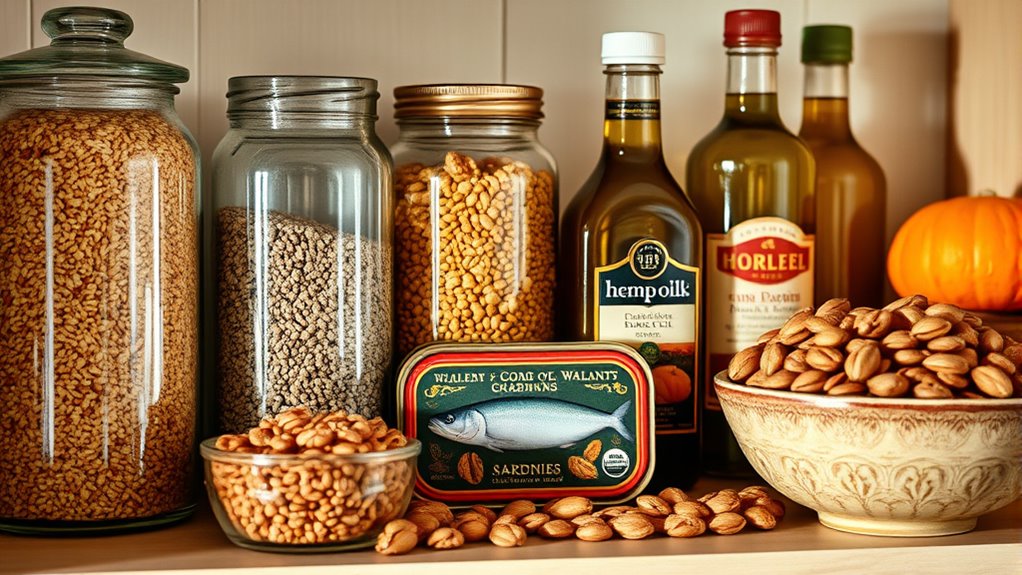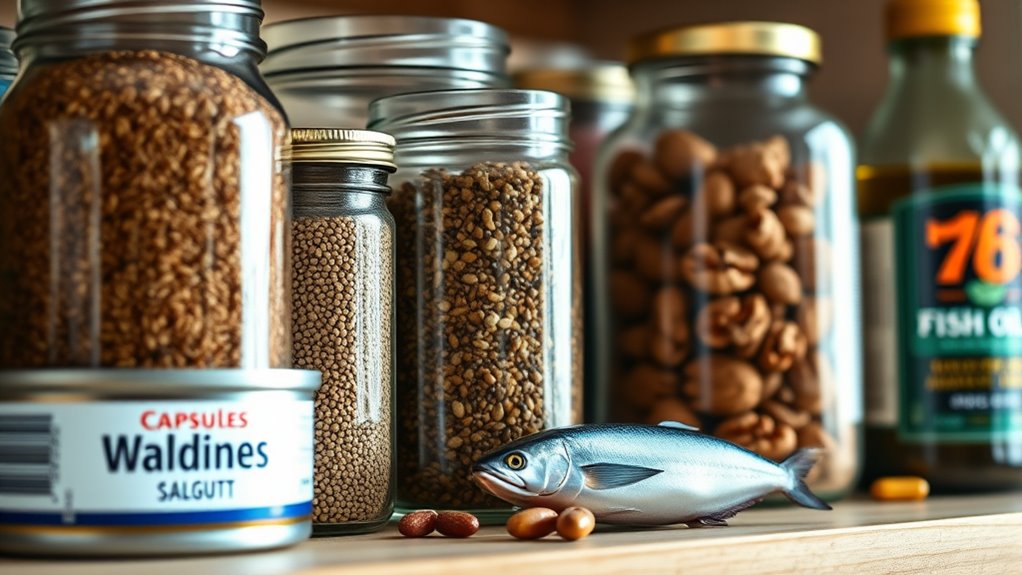Did you know your pantry holds surprising sources of omega-3s? Items like chia seeds and ground flaxseeds are packed with plant-based ALA, easy to add to any meal for heart and brain health. Canned sardines, mackerel, and anchovies are affordable options rich in EPA and DHA, no fresh fish needed. Plus, some fortified eggs, milk, and yogurt boost your intake effortlessly. Keep exploring your pantry—these hidden treasures can help support your overall wellness in ways you might not expect.
Key Takeaways
- Canned sardines, mackerel, and anchovies are affordable, shelf-stable sources rich in EPA and DHA omega-3s.
- Chia seeds and ground flaxseeds are pantry staples high in plant-based ALA omega-3s.
- Some fortified eggs, milk, and yogurt contain added omega-3s for easy daily intake.
- These canned and fortified options offer practical, everyday ways to boost omega-3 consumption.
- Incorporating these surprising pantry items supports heart, brain, and overall health naturally.

Are you getting enough omega-3 fatty acids in your diet? If you’re like many people, the answer might be no. Omega-3s are essential fats your body can’t produce on its own, which means you need to get them from food. While everyone knows about fish oil capsules and oily fish like salmon, there are plenty of surprising sources hiding right in your pantry. You might already have some of these ingredients without realizing their health benefits.
Take a look at your pantry shelves and consider chia seeds. These tiny seeds pack a serious omega-3 punch, specifically alpha-linolenic acid (ALA). Just a tablespoon of chia seeds contains about 2.5 grams of ALA, making them a convenient and versatile way to boost your intake. You can sprinkle them on yogurt, blend them into smoothies, or add them to oatmeal. They’re tasteless, so they won’t alter the flavor of your dishes, and their gel-like texture adds a nice thickness to your recipes. Incorporating chia seeds regularly can help improve your heart health, reduce inflammation, and support brain function. Embracing a diverse range of sources can enhance your creative practice of maintaining a balanced diet.
Chia seeds are a potent, tasteless source of omega-3s that easily boost your health.
Beyond chia seeds, don’t overlook other pantry staples like flaxseeds. Ground flaxseeds are another rich source of ALA. Just two tablespoons provide approximately 3 grams of omega-3s. Like chia seeds, they are easy to add to smoothies, baked goods, or sprinkled over cereals. Both chia and flaxseeds are excellent plant-based options, especially if you prefer to avoid fish or are vegetarian or vegan.
Of course, fish oil supplements are an obvious source, but you might be surprised to learn some canned or preserved fish products also contain omega-3s. Canned sardines, mackerel, and anchovies are affordable, shelf-stable options rich in EPA and DHA, the types of omega-3s most beneficial for your cardiovascular health. These options are often overlooked because they’re associated with fresh fish, but canned varieties retain most of their nutritional value and are a convenient pantry staple.
In addition, fortified foods like eggs, milk, or yogurt sometimes have added omega-3s. Check labels to find products enriched with fish oil or algae oil—another plant-based source of DHA. These options allow you to incorporate omega-3s into your diet effortlessly.
Frequently Asked Questions
Can Plant-Based Foods Provide Sufficient Omega-3s?
Plant-based foods can provide sufficient omega-3s if you include sources like chia seeds, flaxseeds, and walnuts regularly. While they offer plant-based omega-3s (ALA), you might need dietary supplementation to guarantee ideal levels, especially if your body struggles to convert ALA into the more active forms (EPA and DHA). Combining these foods with supplements ensures you meet your omega-3 needs for overall health.
How Do Omega-3 Levels Vary Between Different Food Brands?
While exploring your options, you might notice subtle differences in omega-3 levels across brands. Brand variations often stem from sourcing and processing methods, so label accuracy becomes key in choosing wisely. You’re encouraged to compare product labels carefully, as some brands may slightly overpromise or underdeliver on omega-3 content. By paying close attention, you can guarantee you’re getting the nutrients you seek, making smarter, more informed choices for your health.
Are There Any Risks in Consuming Too Much Omega-3?
You might wonder if too much omega-3 is risky. Consuming excessive fish oil or omega-3 supplements can lead to bleeding problems, immune suppression, or vitamin A toxicity. To guarantee supplement safety, stick to recommended doses and consult your healthcare provider, especially if you’re on blood-thinning medication. Moderation is key; balance your omega-3 intake to enjoy its benefits without risking adverse effects.
How Can I Tell if My Pantry Foods Are Rich in Omega-3?
You can tell if your pantry foods are rich in omega-3 by checking labels for fish oils or omega-rich grains like flaxseed, chia, and walnuts. Look for terms like “high in omega-3” or “fortified with omega-3s.” Foods like canned salmon or sardines are naturally high in omega-3s. Incorporate these into your diet to boost your intake, ensuring you’re getting enough without overdoing it.
Do Cooking Methods Affect Omega-3 Content in Foods?
Think of your omega-3s as delicate dancers on a stage—they need gentle handling. Your cooking techniques can either keep them performing gracefully or cause them to stumble. High heat and prolonged cooking threaten omega-3 stability, causing these essential fats to break down. To protect your healthy fats, opt for gentle methods like steaming or baking. Keep it light and mindful, and your omega-3s will stay vibrant and beneficial.
Conclusion
Now that you know these unexpected omega-3 sources in your pantry, you’re better equipped to boost your health effortlessly. Remember, “A little knowledge is a dangerous thing,” but in this case, it’s your secret weapon for wellness. With these simple additions, you’re planting seeds for a healthier tomorrow. So, keep exploring, stay curious, and let your pantry surprise you—because the path to good health is often right in your own kitchen.









